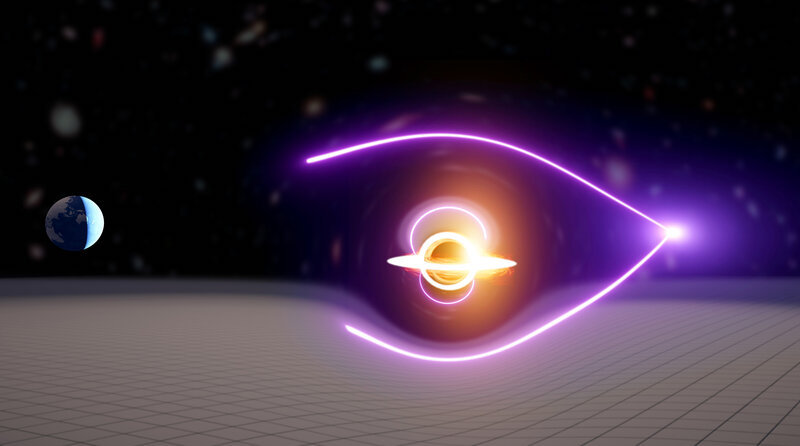
An intermediate-mass black hole is the missing link between two other kinds of black holes – supermassive ones lurking at the centers of galaxies – and stellar black holes, often formed in the implosions that take place when massive stars explode as supernovae. Astronomers believe there should be many mid-size black holes around, but finding them has been hard. This week, though, astronomers published a new discovery of a long-sought “goldilocks” black hole – not big enough to be labeled supermassive, not small enough to rank as an ordinary stellar black hole – with a mass of 55,000 suns. The mass of this black hole falls midway between the other two kinds.
The astronomers published their discovery in the peer-reviewed journal Nature Astronomy on March 29, 2021.
Black holes are famous for devouring everything that gets too close, including light. But, metaphorically speaking, this discovery of an intermediate black hole may shed light on a major astrophysical question: How are supermassive black holes formed? Astronomer James Paynter at Melbourne University is lead author of the study. He said in a statement:
While we know that these supermassive black holes lurk in the cores of most, if not all galaxies, we don’t understand how these behemoths are able to grow so large within the age of the universe.
Intermediate black holes are not easy to observe. They aren’t preceded by a large supernova explosion, as stellar black holes often are. Also, they are smaller and less active than the supermassive black holes, with less gravitational pull to bring in cosmic material into a glowing accretion disk that can be observed, for example, at radio or X-ray wavelengths. So, in order to actually see an intermediate black hole, you’ll generally have to look for the effects it might have on its surroundings.

In this case, the astronomers found the intermediate black holes by detecting something located far behind it: the signals from a gamma ray burst! Gamma ray bursts emit short (fractions of seconds to hour-long) flashes of light at the highest energies (gamma rays in the electromagnetic spectrum).
This particular gamma-ray burst was half a second long. It’s thought to have been emitted by two merging stars. But what made it extra special was that the emission was gravitationally lensed, in such a way that the astronomers didn’t just see the flash of light from the gamma ray burst once, but twice. In other words, the burst had an “echo,” which is a giveaway for a black hole standing in the way of the incoming rays of light. What happens is that all the mass contained in the black hole is powerful enough to bend the light from the burst as it’s passing by, in such a way that astronomers observe the same flash twice.
Not only are intermediate black holes hard to detect but there is currently little understanding on how they were formed. There is no single star that could ever form such a heavy black hole (compared to the stellar ones). One idea is that they were formed in the Big Bang. Eric Thrane from Monash University explained:
This newly discovered black hole could be an ancient relic – a primordial black hole – created in the early universe before the first stars and galaxies formed. These early black holes may be the seeds of the supermassive black holes that live in the hearts of galaxies today.
Another theory is that they may form from smaller stellar black holes that eat their way up in mass by devouring material coming into their way as time passes, or merge with other stellar black holes. And a third idea is that massive stars in dense stellar clusters end up in a runaway collision, with a subsequent collapse of the collision product into an intermediate black hole.
There are also other ways besides gravitational lensing to detect intermediate black hole candidates. For example, NASA reported in 2020 about a similar-sized intermediate black hole, weighing in at 50,000 masses of our sun, which caused a flare of X-ray emission after a star that got too close was torn apart.
In 2019 astronomers detected a gravitational wave signal (GW190521) from two black holes merging. The merger resulting in a more massive black hole, which with its 142 solar masses also counts as an intermediate black hole.
Rachel Webster, professor at the University of Melbourne, said these new findings make it possible for astronomers to make greater strides in black hole evolution research. She said:
Using this new black hole candidate, we can estimate the total number of these objects in the universe. We predicted that this might be possible 30 years ago, and it is exciting to have discovered a strong example.
Through this research, astronomers estimate there are as many as 46,000 intermediate mass black holes in the Milky Way neighborhood.
Bottom line: Astronomers have detected an intermediate black hole – the missing link between supermassive ones and small stellar ones – via gravitational lensing from a background gamma ray burst.
Source: Evidence for an intermediate-mass black hole from a gravitationally lensed gamma-ray burst











